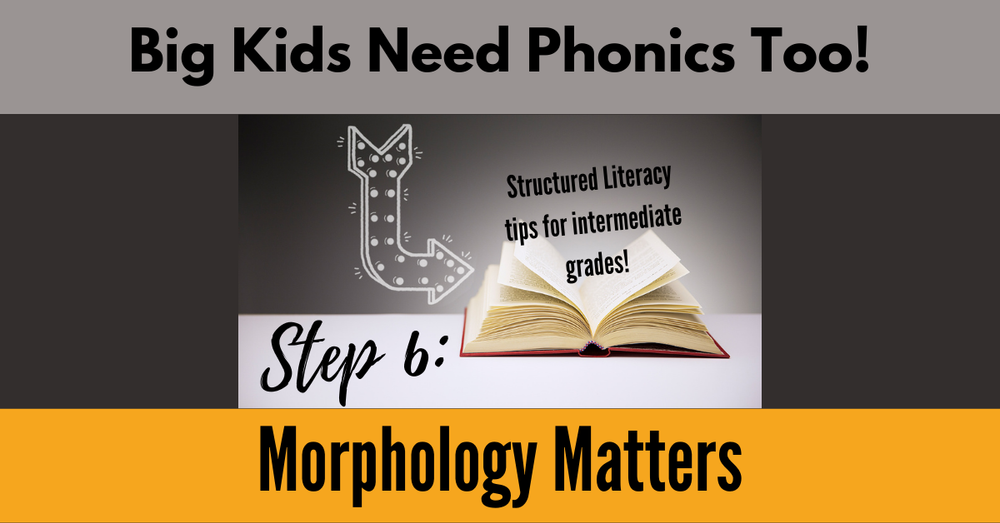What is MORPHOLOGY and Why Does it Matter?
I was recently working with a group of 4th graders on decoding and spelling 3+ syllable words, and I noticed something odd. Whenever I asked them to identify the prefix or suffix in a word, they started calling out random syllables! I know these students have been taught basic prefixes and suffixes, but soon realized that these students didn’t know that affixes differ from syllables in one major way: affixes carry meaning. I knew that we needed to go back to the beginning and explicitly teach morphology to these students who hadn’t just “picked it up along the way.”
So, for the last several months, we have taken a deep dive into morphology and structured word inquiry. It has been so beneficial that I knew it needed to be added as the 6th Step in our BIG Kids Need Phonics Too! Series. While morphology obviously differs from phonics, it is part of the “What to Teach” in Structured Literacy, so we are including it!
The Basics:

What is morphology? Morphology is the study of words.

A morpheme is the smallest unit of a word that carries meaning. So, while a phoneme is the smallest unit of sound, a morpheme is the smallest unit of meaning. The word redo has two morphemes: <re> <do> and four phonemes: /r/ /ē/ /d/ /oo/.
Morphemes are broken down into three categories: prefix, base/root, suffix.




A prefix is a morpheme added to the beginning of a base or root that changes the original meaning.
A suffix is a morpheme added to the end of a base that changes the original meaning.
A base carries the main meaning of a word. Bases can be free or bound. A free base can stand alone as its own word. Bound bases cannot. We often call bound bases, roots. The word root is most often used to describe the etymology or word origin. So, we often hear, Latin Roots and Greek Roots. Use your judgement how much detail your students need to know about these terms.
Free base- can stand alone and be spoken as a word
Bound base- has meaning, but cannot stand alone
Root- most often used when speaking about etymology or word origin (Latin or Greek)
Let's look at the word: plant


This free base carries meaning alone. A plant is a living organism that is able to produce its own food. It can also be used as a verb that means: to place into the ground to grow.
When we see the word, replanted in text, morphology can help us determine the correct meaning.
The suffix, <-ed>, is added to verbs to show that the action took place in the past. We now know this word is the second definition: to place in the ground to grow and that this action took place in the past. We also can look at the prefix, <re-> which means "again or back" and know that something was placed in the ground to grow again or for a second time.
<re> <plant> <ed>
Why is Morphology Important and When Should it Begin?
Morphology is important because reading is about meaning-making!
"Recent research indicates that morphological awareness is associated with reading and spelling growth from first grade onward, in parallel with phoneme awareness and general print knowledge." (Moats 2020). Morphology should be taught from the beginning!
There are four benefits for teaching morphology and teaching it early!

1- Morphology connects the parts of the reading process triangle: orthography, phonology, semantics. It helps us make meaning of the sound and spelling patterns we see.
Without morphology, controlled texts become awkward, and the syntax of the sentences does not feel natural. Explicitly teaching prefixes and suffixes allow us to write decodable passages in a much more natural way. Making the jump from controlled, to authentic text, is the goal. Morphology can make this transition occur earlier.
Teaching morphology is important from the beginning. Don’t wait for intermediate grades!
2. Morphology is important because reading is about meaning-making! Teaching morphology will increase vocabulary and comprehension. It focuses on meaning making, not just decoding sounds!
The four most frequent prefixes (<re>, <un>, <dis>,and <il- im- il- ir>) account for 97% of prefixed words in printed school English. The four most frequent suffixes ( <s, -es>, <ing>, <ed>, and <ly> account for 97% of suffixed words in printed school English.
Even if a student can use decoding strategies to read the word, without morphology, the student has limited ability to make meaning of many words! Notice how morphology, and the basic understanding of these simple prefixes, change the meaning of the base word:
interest: interests, interesting, interested, disinterest, disinterested
A Word Matrix, like below, can help students see the varying meaning-making relationships of bases and affixes.



3. Morphology offers a frame for phoneme-graphing relationships. It is a vital component of spelling instruction and is often the key to spelling that seems illogical. There are morphological explanations for many spelling patterns that first appear irregular.
For example:
because is the prefix <be> + the baseword <cause> = because
does is the base word <do> + the suffix <es>
Once students see these connections, learning these words is about meaning and patterns, and not rote memorization. Historically, pronunciation changes and shifts faster than spelling. If pronunciation does not match spelling, spelling can often be explained using etymology and morphology. Our favorite place to find explanations about irregular words and word origins is https://www.etymonline.com/
4. Morphology can be powerful for dyslexic people. Dyslexia is characterized by having high language comprehension, but low phonological processing. Because morphology is meaning-based, often people with dyslexia excel at morphology. These students tend to be inferential learners and like the ability to draw meaning based on word parts. Once prefixes, bases, and suffixes are taught, Structured Word inquiry can be a strength and source of confidence for students with this reading blueprint.
What are the best ways to implement morphology in your structured literacy instruction?
Morphology instruction should be systematic, sequential, explicit, repetitive, and cumulative. Morphology should not be taught in isolation, but integrated into your structured literacy or Orton Gillingham-inspired lessons! It is integral to overall literacy success. Have I mentioned that you should start teaching basic morphology no later than first grade?
I found this Scope and Sequence posted on many school district websites and in various other places. I have yet to be able to find the original creator to give full credit. I’d love to hear if you know its original source! Until then, thank you to whomever sent this out into the world. This sequence is not an all-inclusive list, but the minimum students should know by the end of the grade level.

Morphology instruction should be systematic, sequential, explicit, repetitive, and cumulative. Morphology should not be about memorization.
Students are more likely to remember and master word knowledge if they are part of figuring out the meaning of unknown words. Memorizing lists of prefixes, roots, and suffixes with little or no investigation or application makes morphology a chore and is less effective.

Use colorful anchor charts and give explicit, direct instruction on the affixes, bases, and roots. Then, PLAY with language. Use word matrices to create new words. Create nonsense words that could have meaning by adding prefixes and suffixes. Construct and deconstruct words! Bring morphology to life.
My latest heart work project was to create 1st- 5th Grade Morphology Matters achor charts, morpheme cards, and graphic organizers to correspond to the scope and sequence. These can be used to create Morphology Walls, pocket chart activities, interactive games, and much more. These can be found here. Finally, if you are looking for a complete, year-long morphology program, you can find it imbedded in Reading Rev's Complete Phonics, Spelling, & Morphology Program, or as a stand-alone product. You will find a Teacher's Manual explaining each morpheme, a student note-taking graphic organizer, a student practice page, and the complete morphology wall set.





Every intermediate classroom needs this morphology wall. See how to build a Morphology Wall here.
This resource is in the Reading Rev VIP site along with the ones below and 100+ literacy resources for intermediate students! Hope to see you inside!




Let us know your favorite ways to make morphology matter in the comments!
~Bri
Want a review of all 6 Steps in the BIG Kids Need Phonics Too! Series? Here you go!
Step 1: Diagnostic Assessments
Step 2: Eliminate the Primary Vibe

